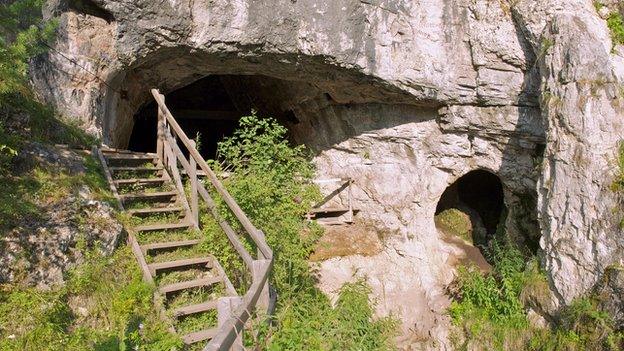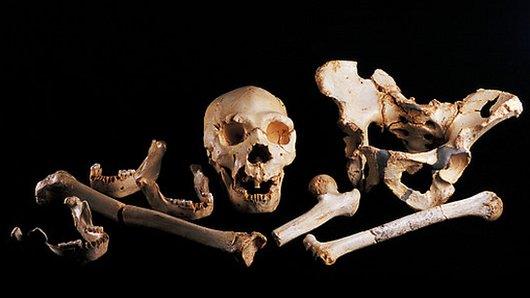Neanderthals could speak like modern humans, study suggests
- Published

Neanderthals may have had complex language
An analysis of a Neanderthal's fossilised hyoid bone - a horseshoe-shaped structure in the neck - suggests the species had the ability to speak.
This has been suspected since the 1989 discovery of a Neanderthal hyoid that looks just like a modern human's.
But now computer modelling of how it works has shown this bone was also used in a very similar way.
Writing in journal Plos One, external, scientists say their study is "highly suggestive" of complex speech in Neanderthals.
The hyoid bone is crucial for speaking as it supports the root of the tongue. In non-human primates, it is not placed in the right position to vocalise like humans.
An international team of researchers analysed a fossil Neanderthal throat bone using 3D x-ray imaging and mechanical modelling.
This model allowed the group to see how the hyoid behaved in relation to the other surrounding bones.
Stephen Wroe, from the University of New England, Armidale, NSW, Australia, said: "We would argue that this is a very significant step forward. It shows that the Kebara 2 hyoid doesn't just look like those of modern humans - it was used in a very similar way."
He told BBC News that it not only changed our understanding of Neanderthals, but also of ourselves.
"Many would argue that our capacity for speech and language is among the most fundamental of characteristics that make us human. If Neanderthals also had language then they were truly human, too."

60,000-year-old Neanderthal remains (replica pictured) also included a hyoid bone (not visible)
It was commonly believed that complex language did not evolve until about 100,000 years ago and that modern humans were the only ones capable of complex speech.
But that changed with the discovery of a Neanderthal hyoid bone in 1989. It was found in the Kebara Cave in Israel and is very similar to our own,
Much older hyoid fossils have also recently been discovered, attributed to the human and Neanderthal relative Homo heidelbergensis. They were found in Spain and are over 500,000 years old, external.
These have yet to be modelled, but Prof Wroe said they were likely to be very similar to those of modern humans and Neanderthals, so could take back the origins of speech still further.
He added that his work would not necessarily be accepted as proof that Neanderthals spoke.
"We were very careful not to suggest that we had proven anything beyond doubt, but I do think it will help to convince a good number of specialists and tip the weight of opinion."

Neanderthals had large faces with massive brow ridges and no chin
Neanderthals were stockier and shorter than modern humans, with no chin and backwards sloping foreheads. They are not regarded as direct human ancestors but DNA analysis has revealed that between 1% and 4% of the Eurasian human genome seems to come from Neanderthals, external.
Dan Dediu, from the Max Planck Institute for Psycholinguistics, Netherlands, published a review article earlier this year, external suggesting that Neanderthals and modern humans shared a similar capacity for language.
He said that the current study brought more weight to the conclusions that Neanderthals had very similar hyoid bones to us, "not only in form but also in what concerns their mechanical properties".
"The authors themselves are understandably cautious in drawing strong conclusions, but I think that their work clearly supports the contention that speech and language is an old feature of our lineage going back at least to the last common ancestor that we shared with the Neanderthals," Dr Dediu told BBC News.
He stressed, though, that the latest study was only a first step and that future work on other living primates were necessary to better understand the range of variation within modern humans.
- Published18 December 2013

- Published4 December 2013

- Published22 December 2010